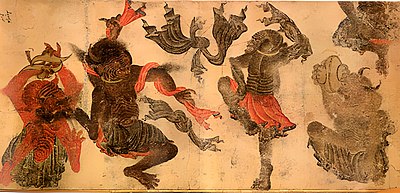
The album of Muḥammad Siyāh Qalam or Siāh-Qalam (lit. 'the Black Pen'; Persian: محمد سیاه قَلَم; Turkish: Mehmed Siyah Kalem) comprise around 80 extant late 14th and early 15th century paintings folios, ink drawings (qalam-siāhi), and calligraphies, on various material, sometimes silk. The albums that contains these paintings, most of which are signed as Mehmet or Muhammad Siyah Qalam, is called the Fatih.[1] These paintings depict cultural and religious ritual norms of the time period, providing insight into the demographics of that era as well as the geography.[1] Measuring up to 335 × 485 cm, these paintings are generally attributed to Iran and bear the strong influence of Chinese art and techniques, as well as symbols of Buddhism and Shamanism, which were both major faiths in the region of Central Asia before the arrival of Islam.[2]
In tone and theme, the images are a highpoint of Persian draughtsmanship and include works from the Mozaffarid, Jalāyerid and Turkmen periods.[3] They are sometimes attributed to the notname Ustad Siyah Qalam; equivalent in English to the Master of the Black Pen. There had been conflicting opinions about whether Siyah Qalam was an individual or a group of artists. This discourse arose because the artwork was done in a non-cohesive style with the name "Siyah Qalam" written and placed differently on each art piece.[1]
The figures depicted in the paintings span a variety of cultures: Iranian, Turkic, Chinese, Mongolic, and date to the century after reign of the Turco-Mongol conqueror Timur. Notable for their intrinsic quality, they contain depictions of diabolic imagery, everyday nomadic life in the Euroasian steppe, and contemporary culture's relationship with the dead.
They are held at the Topkapi Saray Library, Istanbul; parts of the Diez Albums of the Berlin State Library are closely related.[2]
- ^ a b c Erzen, Jale Nejdet (2020). "Mehmet the Black Pen". The Journal of Asian Arts & Aesthetics (6): 83–89. doi:10.6280/JAAA.202005_(6).0008.
- ^ a b Bloom; Blair, 21
- ^ "Siāh-Qalam 'black pen" the genre of paintings or drawings done in pen and ink; the painters of such drawings". Encyclopædia Iranica. Retrieved 27 September 2015